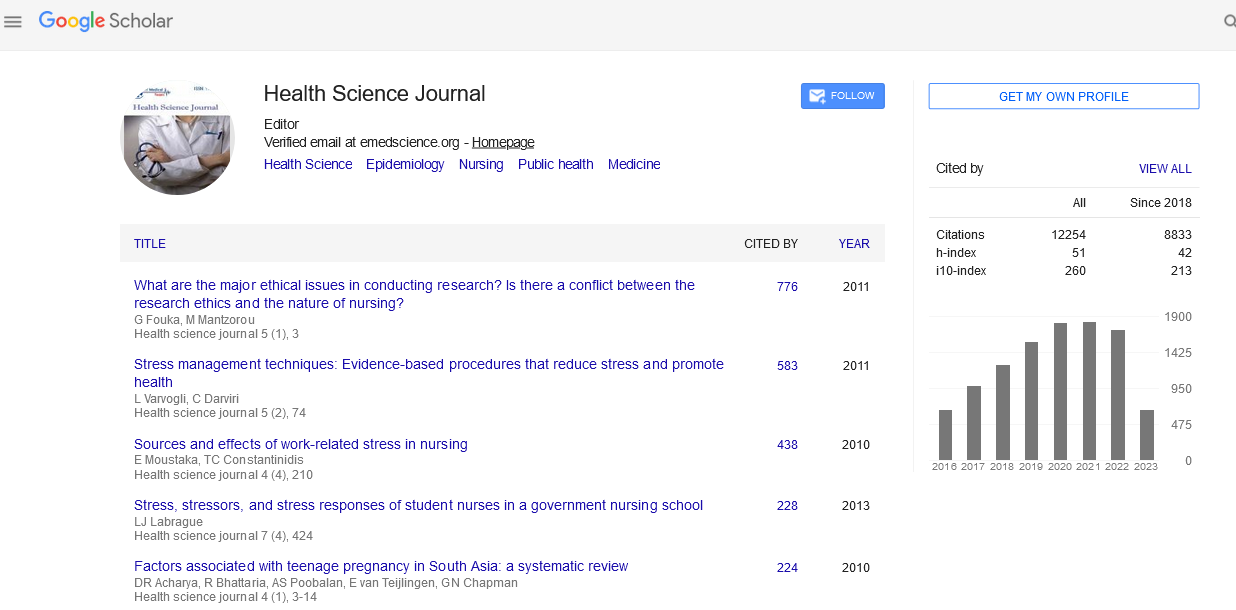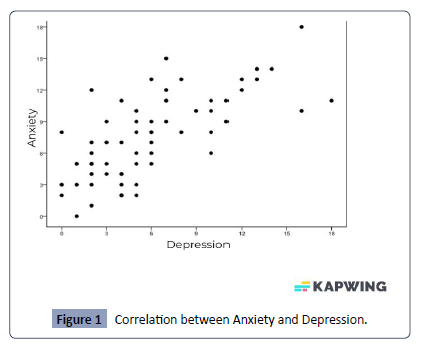Abstract
The study looks into the connection between anxiety and depression in a sample population. A total of 68 patients were assessed for their level of anxiety and depression using the Hospital Anxiety and Depression Scale (HADS) developed by Zigmond and Snaith in 1983. These findings suggest that anxiety levels have a strong positive relationship with levels of depression r(66) =0.693, p <0.01; this means that higher levels of depression correspond to higher levels of anxiety. Thus, it is necessary to understand how these two emotional disorders interact for purposes of enhancing therapeutic interventions as well as coping mechanisms. The research also corresponds with earlier studies which identified similar relationships across various demographics such as students, athletes, and people suffering from psychiatric conditions. From this perspective, there is need for more specific interventions aimed at decreasing co-occurrence of these disorders as highlighted through this all-inclusive research on anxiety and depression.
Keywords
Anxiety; Depression; Correlation; Hospital Anxiety; Depression Scale (HADS); Psychometric assessment
Introduction
Psychology has been a great field of research on the link between anxiety and depression as both of these psychological states often coexist and can affect people’s quality of life very much. They are emotional disorders that can occur in different age groups as well as populations thereby complicating diagnosis and treatment when they interact.
In this study, we will investigate the relationship between anxiety and depression using the Hospital Anxiety and Depression Scale (HADS) developed by [1]. This is a reliable and valid instrument extensively used to measure anxiety and depression among clinical or research population.
Convenience sampling was used to select 68 participants who constituted the sample for this study. Participants were asked to complete HADS which had 14 questions with 7 items measuring anxiety while another seven items measured depression. The Pearson correlation analysis was used in analyzing data so as to establish how these two variables are related.
For successful therapeutic interventions, it is important to understand the association between anxiety and depression. This study’s findings will help improve coping mechanisms, therefore preventing negative outcomes that may result from having both disorders together at once.
Methodology of Research
For the study, 68 participants were sampled on grounds of convenient access. The subjects were required to fill in a survey which employed Hospital Anxiety and Depression Scale (HADS) developed by Zigmond and Snaith in 1983, known to be a valid and reliable measure for anxiety and depression [2]. HADS contains fourteen questions including seven that assess anxiety and other seven assessing depression. Each item is scored in a four-point range with higher numbers indicating more severe forms of anxiety or depression. To ensure honesty and accuracy, respondents completed the questionnaire under controlled conditions. Afterward, data from the questionnaires were entered into SPSS software for analysis.
To begin with, total scores for anxiety and depression were summed up on each participant. In respect to sample’s overall levels of anxiety and depression, mean (M) scores as well as standard deviations (SD) of these scores were written down respectively. As regards anxiety a mean score equals M=7.57 was accompanied by a standard deviation equal SD=4.05; whereas for depression M=5.77; SD=4.22 [Table 1].
| |
Mean |
Std. Deviation |
N |
| Anxiety |
7.5735 |
4.05307 |
68 |
| Depression |
5.7794 |
4.22093 |
68 |
Table 1: Descriptive Statistics
The Pearson correlation coefficient (r) was used subsequently to ascertain whether there was an interrelation between anxiety as well as depression levels. This statistical index is used to measure the strength and direction of the linear relationship between two continuous variables. In this study, the correlation coefficient was computed and tested for its significance at a p-value level of less than 0.01 [Table 2].
|
|
Anxiety |
Depression |
| Anxiety |
Pearson Correlation |
1 |
0.693** |
| Sig. (2-tailed) |
|
0.000 |
| N |
68 |
68 |
| Depression |
Pearson Correlation |
0.693** |
1 |
| **.Correlation is significant at the 0.01 level (2-tailed). |
Table 2: Correlations
The results revealed that anxiety and depression had a strong positive correlation with a correlation coefficient of r(66) =0.693, which was significant at p <0.01. This implies that higher anxiety levels are associated with higher depression rates, while lower levels of anxiety result in lower depression rates. Our research model enabled us to establish a connection between anxiety and depression among the investigated population as well as determine how statistically significant is this relationship.
Results
Data analysis showed these findings: Anxiety was measured by using M=7.57 which is the mean score for anxiety in the sample with SD=4.05 representing standard deviation data from this analysis. It means that different people participating in the study have got different anxiety levels – some individuals were highly anxious while others were not quite worried at all. Depression had M=5.77 with a SD=4.22 as its mean score and standard deviation respectively indicating that there was variation in depression among respondents where some suffered only slightly from depressive symptoms compared to others who were highly depressed.
Anxiety and depression were highly correlated based on a statistical analysis carried out using Pearson correlation coefficient. The calculated correlation coefficient was r (66)=0.693, p<0.01, which was statistically significant. This means that there is an association between high anxiety levels and elevated depression levels, and vice versa. The result of the test was statistically significant, which shows that anxiety and depression are not just random variables but truly have something in common in the group being studied.
These outcomes are depicted in [Figure 1], graphically showing the distribution of scores for both anxiety and depression as well as their high positive relationship. Thus, it may be concluded from the findings that our initial hypothesis has been confirmed since there is a positive correlation between anxiety and depression which calls for further investigations and interventions into these psychological conditions. In other words, this implies that there exists a statistical significance between the two variables [Figure 1].
Figure 1: Correlation between Anxiety and Depression.
Discussion
The purpose of this study therefore is to examine if there is any linkage between anxiety with depression as well. Our research hypothesis was that these two factors are related to each other These findings indicate that there is a positive correlation between anxiety and depression, in other words, the rejection of the null hypothesis implies that more anxiety leads to higher levels of depression and vice versa.
According to Weinstein, [3], this was similarly established by a research which showed that anxiety and depression are positively correlated among athletes who train professionally. Moreover, our study’s results agree with previous surveys that have linked anxiety to depression as well as suggested that low B12 level cause them [4]. In comparison, an investigation focusing on students unveiled similar trends where first-year and second-year learners presented high levels of the two disorders while those satisfied with school scored lower rates of tension or stress [5].
Also having used a large sample of students, healthy adults and psychiatric patients [6] found out high correlations between anger scores and measures of anxiety and depression. As reported in the above studies, there existed a positive correlation between the two studied factors not only in adults but also in adolescents who devoted a considerable amount of their free time to engaging in online gaming [7]. Found that anxiety and depression levels were higher among those adolescents familiar with them compared to those who were not. For example [8], argue that while anxiety depression parameters show a high correlation among adolescents, children on the other hand tend to have higher anxiety levels than depression ones.
On the other hand, however, different research findings showed that there was a significant distinction between anxiety levels when compared with depression levels; hence former being higher. Both factors were discovered more frequently in females as well as residents from urban areas [9]. A significant difference from our study is that unlike ours every participant in this particular study was an epileptic patient. In addition, another investigation established differences between the two genders revealing that women had greater amounts of anxiousness than men. Furthermore, men had more depressive symptoms compared to women [10].
All the participants were of Arab origin and so cultural variations exist. Furthermore, even though depression have a positive contribution to anxiety, the levels of these two variables may depend on age, as anxiety has been found to be higher in young ages but it starts declining at adult life while for instance depression is more common around thirty years old [11].
Some restrictions however existed within the current study. Participants’ selection was based on availability. Thus, general population implications cannot be made from this sampled data analysis [12]. There were several related friends in the sample who will respond to questionnaires subjectively. Also, should the sample include only psychiatric disorders diagnosed patients; responses may vary to some extent. In future research could concentrate on analyzing these two variables in a specific work group say medical personnel. Early detection of symptom of anxiety and depression can facilitate their easier control and prevention of negative outcomes that follow them.
References
- Zigmond AS, Snaith RP (1983) The Hospital Anxiety and Depression scale. Acta Psychiatrica Scandinavica 67: 361-370.
Indexed at, Google Scholar, Crossref
- Michopoulos I, Kalkavoura X, Michalopoulou P, Fineti K, Kalemis G, et al. (2007) The anxiety and depression scale in the general hospital (HADS). Validation in the Greek population. Psychiatry 18: 5-12.
Indexed at, Google Scholar, Crossref
- Weinstein A, Maayan G, Weinstein Y (2015) A study on the relationship between compulsive exercise, depression, and anxiety. Journal of Behavioral Addictions 4: 320-323.
Indexed at, Google Scholar, Crossref
- Todorov AA, Chumpalova-Tumbeva PG, Stoimenova-Popova MY, Popova VS, Todorieva-Todorova DK, et al. (2017) Correlation between depression and anxiety and the level of vitamin b12 in patients with depression and anxiety and healthy controls. J Biomed Clin Res 10: 140-145.
Indexed at, Google Scholar, Crossref
- Bayram N, Bilgel N (2008) the prevalence and socio-demographic correlations of depression, anxiety, and stress among a group of university students. Social Psychiatry and Psychiatric Epidemiology 43: 667-672.
Indexed at, Google Scholar, Crossref
- Mook J, Van Der Ploeg HM, Kleijn WC (1990) Anxiety, anger, and depression: Relationships at the trait level. Anxiety research 3: 17-31.
Google Scholar, Crossref
- Fazeli SZ, Mazdarani Z, Hosseini SH (2018) Relationship between duration of gaming with anxiety and depression. Journal of Mazandaran University of Medical Sciences 28: 146-151.
Google Scholar
- Brady EU, Kendall PC (1992) Comorbidity of anxiety and depression in children and adolescents. Psychological Bulletin 111: 244-255.
Indexed at, Google Scholar, Crossref
- Gupta S, Sharma N, Bharti S, Sharma R, Kohli A, et al. (2018) Depression and anxiety in patients with epilepsy. International Journal of Advances in Medicine 5: 1268-1273.
Google Scholar, Crossref
- Al-Qaisy LM (2011) The relation of depression and anxiety in academic achievement among a group of university students. International Journal of Psychology and Counselling 3: 96-100.
Indexed at, Google Scholar, Crossref
- Karadağ E, Sölpük N (2018) Relationship between Depression and Anxiety Symptoms: A Meta-analysis Study. Dusunen Adam the Journal of Psychiatry and Neurological Sciences 31: 1-14.
Indexed at, Google Scholar
- Coolican H (2014) Research Methods and Statistics in Psychology. East Sussex: Psychology Press.
Google Scholar, Crossref






